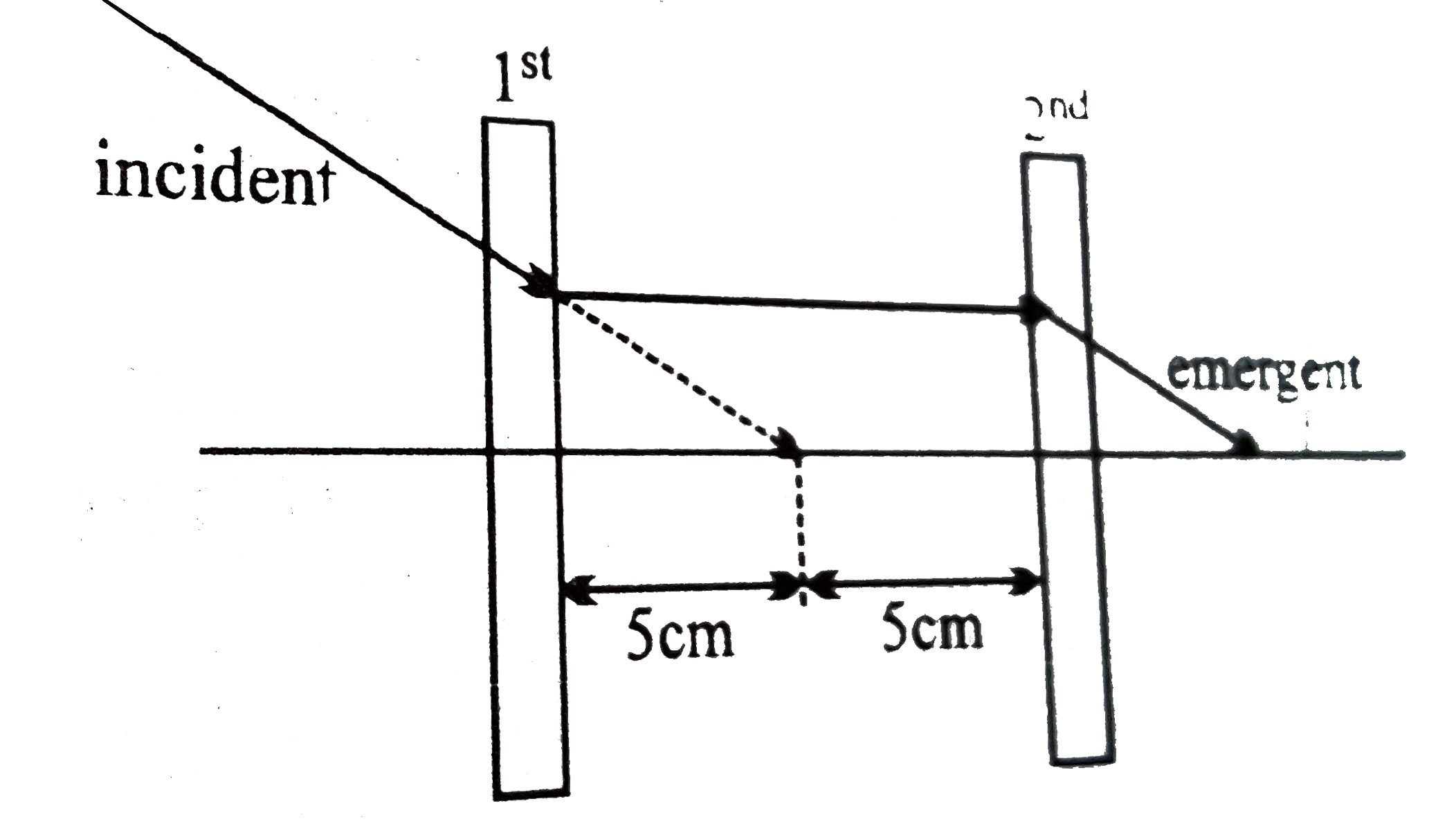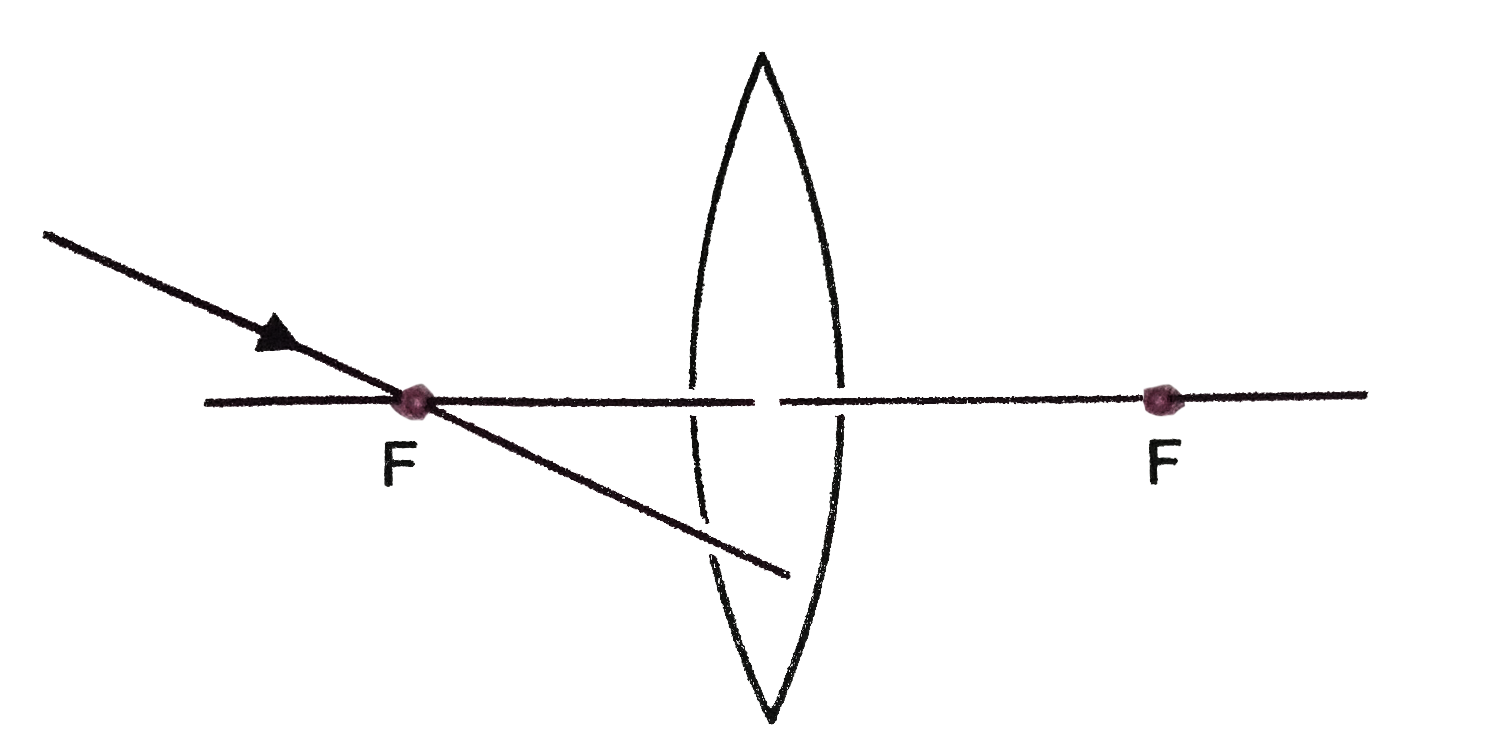Look at the ray diagram shown ,what will be th focal length of th e1stand the 2ndlens,if the incident light ray passes without any deviation?
 Solution in Gujrati
Solution in Gujrati
The correct Answer is:C
From figure 1st behave as diverging and 2nd behave converging
In 1st incident ray appear to pass at 5 cm distance point and after refraction it becomes parallel to principal axis i.e. the focal length = -5cm and for second f=5 cm
Topper's Solved these Questions
- GEOMETRICAL OPTICSBOOK - ALLEN CHAPTER - GEOMETRICAL OPTICSEXERCISE - EXERCISE-2
44 Videos
- GEOMETRICAL OPTICSBOOK - ALLEN CHAPTER - GEOMETRICAL OPTICSEXERCISE - EXERCISE-3
12 Videos
- GEOMETRICAL OPTICSBOOK - ALLEN CHAPTER - GEOMETRICAL OPTICSEXERCISE - EXERCISE - 05 (B) (ASSERTION & REASON )
9 Videos
- CURRENT ELECTRICITYBOOK - ALLEN CHAPTER - CURRENT ELECTRICITYEXERCISE - EX.II
66 Videos
- GRAVITATIONBOOK - ALLEN CHAPTER - GRAVITATIONEXERCISE - EXERCISE 4
9 Videos
Similar Questions
Two mirrors are inclined at angle θ as shown in figure. Light rays are incident parallel to one of mirrors. Light will start retracing its path after the reflection if
View SolutionPlane mirrors are arranged parallel to each other as shown in column-I and the number of images formed by the combination is in column- II
_E01_090_S01.png)
View SolutionStatement-1: The total translational kinetic energy of fall the molecules of a given mass of an ideal gas is 1.5 times the product of its pressure and its volume because.
Statement-2: The molecules of a gas collide with each other and the velocities of the molecules change due to the collision.
View SolutionIn the Bohr's model of hy drogen atom, the electron moves around the nucleus in a circular orbit of radius 5×10−11m. Its time period is 1.5×10−16s. The current associated with the electron motion is:-
View SolutionAssertion : The difference in the value of acceleration due to gravity at pole and equator is proportional to square of angular velocity of earth.
Reason : the value of acceleration due to gravity is minimum at the equator and maximum at the pole.
View SolutionAssertion: Ray of light passing through optical centre of a lens goes undeviated. Reason: Ray falls normal at optical centre and in normal incidence, there is no deviation of light.
View SolutionA ray of light AO is incident on a diverging lens as shown in figure. The focal plane of the lens is also given. The possible direction of the refracted ray will be

View SolutionWhich of the following ray diagrams is correct for the ray of light incident on a lens shown in Fig. ? Choices are given in Fig.

View SolutionDraw the path of light ray passing through a prism. Label angle of incidence and angle of deviation in the ray diagram.
View SolutionFrom the ray diagram shown in Fig. calculte the focal length of concave lens.
 .
.
View SolutionA ray of light is incident on a prism as shown in fig. Find the total deviation suffered by the ray if /_BAC = 1^(@) and /_CAD = 2^(@) .
View SolutionA lens does not produce any deviation of a ray of light passing through …………. .
View SolutionName the part of a lens through which a ray of light passes without suffering any deviation.
View SolutionA ray of light passes through an equilateral prism such that the angle of incidence is equal to the angle of emergence and latter is equal to (3/4)th the angle of prism. The angle of deviation is
View Solution____________ of a lens is a point situated on its principal axis, a ray of light passing through which goes straight without any deviation.
View SolutionA ray of light passing through an equilateral triangular glass prism from air undergoes minimum deviation when angle of incidence is 3/4 th th of the angle of prism. Calculate the speed of light in the prism.
View Solution
